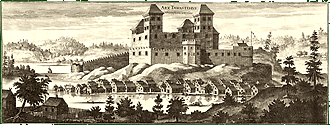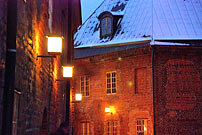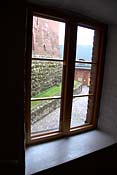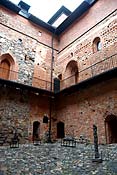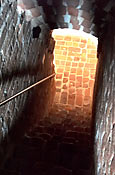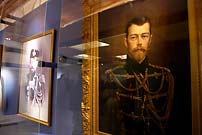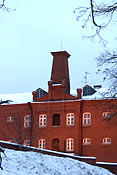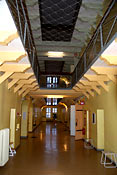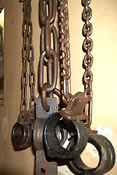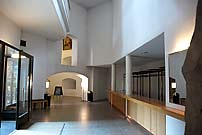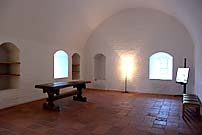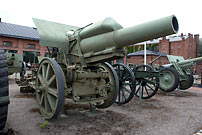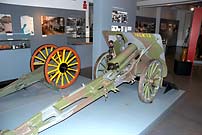History of Hämeenlinna fortress
Castle Häme was found by Swedes in 13 AD on the little island of Vanajvesi Lake for consolidation of crown power at new annexed land. The land had a very bothersome neighbors such as Karelian and Novgorod's people. Häme was a strongest fortification in Finland before Vyborg castle establishment.
Häme was mentioned in "Erik Chronicles" in connection of Birger Magnusson's crusade to Finland in 1249. First fortification was erected presumably at Hakoinen hill in 15 km south of the modern Hämeenlinna fortress. First record about Tauestahus fortress dates of 1309.
There was a fortified war camp on the hill with 7 m. height stone wall and four square towers.
In 14 AD buildings of barracks, warehouses and land-lord dwelling were erected inside of the wall circle and war camp got looks of medieval castle. Now there was a massive shell keep with corner towers and forburg around it.
In 1311 the fortress was besieged by Novgorod's troops. Novgorod chronicles tells about 3-day long siege of Swedes fortress named Vanaj - presumably Häme fortress. Hameenlinna was not seized and Novgorod's trooper got away wasted their time. It was only siege with arms in the fortress history.
Defence value of Hämeenlinna begun decreased after Vyborg fortress establishment, but construction works were continued. Second floor appeared in the castle and it's got it's modern look. Also it had defence wall of 11 m. height with wooden parapet. In 16 AD two round artillery towers were added to the fortress (only one preserves till nowadays).
In the end of 16 AD Hämeenlinna fortifications dilapidated and in 1606 castellan Eric Hare initiated renovation of the fortress. In 1614 king Gustav II Adolf with Queen visited the castle. In 1634 administration of Häme region was transferred to Ojanen town because of administration reforms and the fortress was near to abandoned. In 1659 there was a big fire in the castle.
In 1639 Governor of Finland Per Brahe granted city right to settlement near to the fortress. Hämeenlinna town begun from that time.
September 1713 the fortress was seized Russian troops without fight during Great Northern War. The fortress was a supply base for the Russian Army till August 1721 when peace was concluded in Nystadt. The castle also was a prison for local Finnish guerillas and some local nobleman.
In 1741 during next Russian-Swedes War 1741-1743 Hämeenlinna was surrendered without fight again, but fortress remained under Swedes rule after the war.
In 1723 the fortress become place d'armes of all Swedes troops in Finland. The castle was used as granary and commissary (food depot). Crown Bakery was constructed near to the Castle in 1740.
In 1777 fortress was reconstructed along with design of Magnus von Arbin. New curtains and bastions has been erected. King of Swedes Gustav III visited the fortress several times in 1780's.
March 6, 1808 Hämeenlinna fortress was surrendered to Russians without fight under the order of Swedes commander earl Klingspor. Russian period of the fortress's history become.
Russians used the fortress as army's base and state county prison. In 1837 the Castle was reconstructed for prison's needs along with design of famous architect Karl Engel. The female prison was established here in 1881. It was a first institution of such type in Finland. First voices in favour of the Castle preservation appeared in Finnish press in that times.
First monograph about history and architecture of Hämeenlinna was printed in 1917. In 1953 exploration and restoration works in the Castle started after removing female prison from it. This prison remained in the fortress buildings till 1972. In 1979 the Castle was opened for visitors and in 1988 renovation works were finished here. The fortress got a look of 1800's.
Hameenlinna impressions
There are few medieval fortifications in Finland in comparison of Italy or France so Hameenlinna needs to be visited surely. Very curious example of medieval castle usage. History of Finland in nutshell. If you are artillery enthusiast you'll can't skip it because of it's Artillery museum.
Land forts and fortress:
Bip Castle Gatchina Ivangorod Izborsk Kexholm Kirillov Monastery Koporye Novgorod Pechorskiy Monastery Peter&Paul Fortress Porkhov Pskov Schlisselburg Staraya Ladoga Tikhvin Vyborg Hameenlinna Hamina Kastelholm Kymenlinna Lappaenranta Raseborg Castle Savonlinna Tavetti Turku Visby Fredrikstadt Fredriksten Hegra Fort Hoytorp Fort Arensburg Narva Tallinn Antipatris Caesarea Jerusalem Latrun Fort Masada
Sea forts and fortresses:
Alexander Fort Ino Fort Krasnaya Gorka Fort Kronstadt: Kotlin isl. Kronstadt: North Forts Kronstadt: South Forts Trongsund Hanko Svartholm Sveaborg Marstrand Siaro Fort Vaxholm Oscarsborg
Artillery batteries and individual guns:
Coastal Artillery Hemso Fort
Fortified areas and defensive lines:
Karelian Fortified Area (KaUR) KrUR Leningrad Mannerheim Line Nevsky Bridgehead VT Line Harparskog Line Salpa Line Gothland
Russian
S e a r c h All news

